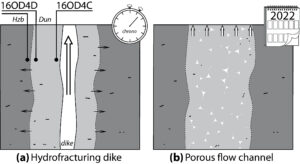Klaessens, D. ; Reisberg, L. ; Jousselin, D. ; Godard, M. ; Aupart, C. (2021) Earth and Planetary Science Letters, 572, 11711
The oceanic crust, covering two-thirds of the Earth’s surface, is formed along mid-oceanic ridges by crystallization at shallow levels of melts formed at depth by partial melting of mantle peridotite. Yet, the process of melt transport to the ridge axis remains poorly understood. Ophiolites, which provide a window into the uppermost mantle, contain dunite bodies often interpreted as relics of melt flow conduits, formed by pyroxene dissolution during melt-peridotite interaction. Here, we present structural and geochemical data on peridotites from the southeastern Oman ophiolite where three types of dunite, corresponding to the Moho transition zone (MTZ), the main and basal mantle sections, are identified. We focus on osmium isotopes, which are particularly well-adapted to tracing melt flow through peridotites. Osmium isotope signatures from host harzburgites accord with abyssal peridotite values and do not vary systematically with setting. In contrast, dunite Os compositions depend on structural context. Basal dunites display compositions similar to harzburgite values, while MTZ dunites have highly radiogenic compositions similar to those of the overlying crust, requiring extensive interaction with melts more radiogenic than MORB. Modeling shows that melts percolating through and equilibrating with dunite channels would acquire unradiogenic compositions, inconsistent with the observed Os signatures of MTZ dunites and lower crust. Thus, our findings require melt transport without equilibration with dunite or harzburgite, arguing for rapid or at least chemically isolated melt migration from the mantle source to the Moho.




